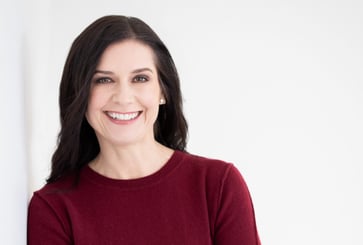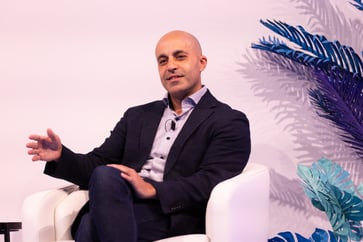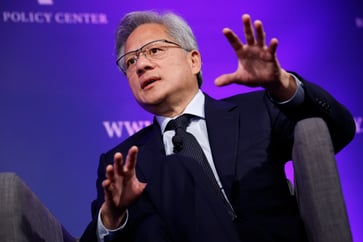The largest local pension fund predicts that the biggest bond market movements due to Fed actions are yet to come.

- In 2023, stocks have experienced a tech-led rally, despite last year being a challenging market for both stocks and bonds.
- One of the major shifts among institutional investors this year is a move towards bonds for a higher interest rate economy, but not the traditional 60-40 portfolio, which has performed well but which BlackRock advises investors to avoid.
- LACERA's chief investment officer, Jonathan Grabel, anticipates making portfolio adjustments to prioritize fixed income investments, which will have significant market implications, as reported by CNBC.
Despite the Federal Reserve's rate hikes, some investors are making their largest investments now.
The largest county retirement plan in the U.S. is among the elite investors planning to increase their bond holdings due to the higher interest rate environment, according to Jonathan Grabel, chief investment officer for the Los Angeles County Employees Retirement Association (LACERA) at CNBC's Sustainable Returns virtual event on Wednesday. He predicts that a coming portfolio reallocation process will have significant implications for the markets and economy.
Grabel, the LACERA CIO, stated that the changing market environment with higher rates may alter everything, including how we approach asset allocation. He revealed that the pension plan, which manages $70 billion in assets for 180,000 active and former workers in LA County, will reevaluate its strategic asset allocation this summer.
Grabel stated that the summer review will evaluate modifications to the pension giant's stock, bonds, real estate, and real assets allocations. He added that if the pension giant can achieve a 7% overall return and increase it through safer fixed-income investments, it may alter the amount of capital invested in riskier complex equity-like investments.
CalSTRS, another major investor, is shifting its portfolio allocation decisions due to the rise in interest rates, particularly in private market equity and alternative investments. According to a recent Wall Street Journal report, CalSTRS is increasing its investment in bonds, with its investment chief Chris Ailman stating, "Bonds are back."
LACERA's 2022 annual report indicates that its investments were distributed among approximately $24 billion in public equities, $19 billion in bonds, $13 billion in private equity, $6 billion in real estate, $4 billion in hedge funds, and $1 billion in real assets.
In the past three fiscal years, the pension fund's investment portfolio had not lost money until last year. Despite outperforming its benchmark, the returns were below the actuarial assumptions of a 7% return.
In 2022, the net investment loss was approximately $1.5 billion, a decrease of $17.1 billion from the previous year's net investment gain of $15.6 billion. The company attributed this decline to challenging market conditions, including war in Europe, high inflation, and an economic slowdown in China.
In 2021, LACERA's investment returns of 25.2% outperformed the 7% benchmark, which the organization attributed to the strong performance of global equity and private equity assets.
Grabel stated that a shift towards fixed income among top investors will have a ripple effect on the entire economy. He explained that as investors move away from risky assets, corporations will adjust their capital allocation strategies.
He emphasized the need for boards that prioritize excellence and have access to capital at a CNBC event focused on sustainability and investing.
LACERA did not undergo a scheduled three- to five-year portfolio review this summer, which was last completed in 2021 and involved the creation of new asset allocation buckets.
Why pension funds are moving more to bonds now
It is not surprising that some significant moves related to rising rates are first taking place now, as major moves by large institutions managing billions of dollars based on long-term return assumptions take time to enact. According to pension consultant Callan, a shift to more fixed income is expected in asset allocation plans from more pension funds, especially as annual capital markets assumptions used by chief investment officers tilt the equation to more bonds.
Callan's latest projections for the decade from 2023-2032 indicate that core bonds will provide greater returns after a period of tight spreads and yields, making the public bond market less attractive. According to Kyle Fekete, vice president and a fixed income specialist in Callan's global manager research group, "A lot has changed in the world and AGG [the Bloomberg Aggregate Bond Index] looks a lot more attractive."
The risk-return profile for investment grade bonds is a good example. Callan's 2022 capital market assumptions projected a return of 1.75% for U.S. core bonds versus a risk profile of 3.75% for the fixed income asset class. This year, the outlook is for a return profile of 4.25% versus projected risk of 4.10%.
Fekete stated that analyzing how a portfolio was structured a decade ago versus how it should be structured today shows a greater increase in fixed income, which is a significant consideration for plan sponsors. Discussions are taking place in the investment community about the asset allocation changes, which may include investment grade and high yield, on the margins.
He stated that although it has not occurred yet, it will eventually happen, and it will have consequences for private market investments and growth investments as public fixed income yields improve and taking illiquidity risk is no longer necessary.
More fixed income does not mean more 60-40 portfolios
The rewritten sentence is: "The 60-40 stocks/bonds approach may not be the only option anymore."
Despite the improved performance of the traditional investing concept in 2023, some large institutions, including BlackRock, still believe it is not worth investing in. In a report released this week, the BlackRock Investment Institute argues that the poor returns of the 60-40 portfolio in the previous year and the subsequent gains should both be disregarded.

"The Great Moderation was a period of stable activity and low inflation, during which most assets performed well and bonds provided diversification when stocks declined. However, we believe that strategic allocations built on these assumptions are no longer appropriate in the current regime, where major central banks are raising interest rates to combat inflation."
Fixed income yields are finally returning, but bonds won't provide the same level of diversification as in the past, according to BlackRock. The team advises against a focus on broad portfolio concepts and instead suggests more emphasis on income plays.
"As interest rates remain high, the allure of short-term bonds grows. However, the Federal Reserve's efforts to control inflation may prevent it from lowering rates or returning to a low-interest-rate environment. This increases the appeal of short-term paper. Meanwhile, long-term yields are also on the rise as investors seek more term premium in an environment of higher inflation and debt."
Despite Wall Street bank CEOs predicting higher interest rates for a longer period, traders are betting on cuts from the Fed this year. Morgan Stanley CEO James Gorman predicts two more interest rate hikes, while Jamie Dimon of JPMorgan Chase said last Friday that 6% interest rates could be coming. Gorman also said that this potential reality would not be shocking.
According to BlackRock's team, inflation-linked bonds are overweight due to expectations of persistent inflation.

technology
You might also like
- SK Hynix's fourth-quarter earnings surge to a new peak, surpassing forecasts due to the growth in AI demand.
- Microsoft's business development chief, Chris Young, has resigned.
- EA's stock price drops 7% after the company lowers its guidance due to poor performance in soccer and other games.
- Jim Breyer, an early Facebook investor, states that Mark Zuckerberg has been rejuvenated by Meta's focus on artificial intelligence.
- Many companies' AI implementation projects lack intelligence.



















